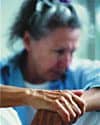The question of whether a 35-year-old scoring criterion of delta sleep in elderly patients should be modified is explored.

Since 1968, however, much has changed in the field of sleep medicine and polysomnographic technology. Over the past three decades, sleep researchers and clinicians have accumulated a wealth of clinical evidence regarding sleep physiology in both the healthy and sleep-disordered adult. In addition, a tremendous advance in the technology of sleep data acquisition and analysis has occurred as a result of the infusion of digital technology into mainstream clinical testing of sleep disorders. Furthermore, the increase in public awareness of sleep disorders spearheaded by such organizations as the National Sleep Foundation over the past several years has led to an enormous increase in the demand for sleep testing by the general public, in particular the elderly. Increasingly, sleep technologists, clinical polysomnographers, and researchers are facing the predicament of having to apply 35-year-old scoring criteria to a general population whose composition and demographics have changed significantly since the inception of the criteria. Today, it is obvious that the R&K criteria suggest several limitations and shortcomings. One of these limitations involves the scoring of delta sleep in elderly patients.
What is delta sleep?
Delta sleep is also known as slow wave sleep (SWS) or deep sleep. It comprises both sleep stages 3 and 4. These are characterized by slow, high-amplitude waves with a frequency of less than 2 Hz and an amplitude of at least 75 mV. K complexes and spindles may be present throughout delta sleep but may be obscured. This type of sleep makes up about 25% of a normal adult’s sleep. In children, teenagers, and young adults, it may be much more prevalent.
A closer look at the 75 µv Rule
According to the R&K Manual, Stage 3 is defined as “an EEG record in which at least 20% but not more than 50% of the epoch consists of waves of 2 cps or slower which have amplitudes greater than 75 µv from peak to peak (the difference between the most negative and positive points of the wave). The figures 20% and 50% refer specifically to the time occupied by the high amplitude, slow waves, and do not include intervals of higher frequency and lower amplitude activity between these waves. In actual scoring practice, it will be necessary to make wave by wave measurements only for epochs with borderline amounts of high amplitude, slow wave activity, ie, about 20% and 50%.”1
Stage 4 is defined as “an EEG record in which more than 50% of the epoch consists of waves of 2 cps or slower which have amplitudes greater than 75 mV peak to peak. Although only slightly more than half of an epoch may actually contain high amplitude, slow waves which meet the above specifications, most stage 4 epochs have the appearance of being completely dominated by this activity. Intervals of lower amplitude, faster activity rarely persist for more than a few seconds in stage 4, but are usually prominent in stage 3 epochs.”1
Interestingly, there was considerable debate regarding the application of an amplitude criterion in addition to a frequency criterion when scoring SWS. The R&K Committee acknowledged the fact that waveform amplitude is influenced by several variables, including cerebral activity, electrode resistance, time constants, electrode placement, and inter-electrode distance. The Committee concluded that, for purposes of scoring and particularly for reliability of scoring, the detection and rating of slow wave activity must require a relatively high amplitude criterion. The reasons cited for this decision were retention of previously published research regarding the amplitude criterion and that the criterion would inadequately address the variations without having a markedly high amplitude criterion. Although the Committee recognized that it is possible that alternative measures of slow wave activity might be useful and empirically significant, they cautioned that departures from the specified criteria be reported in detail.1
Changes in SWS with Age
High-amplitude, slow-frequency electroencephalographic (EEG) waves in non-REM are absent at birth. These slow waves begin to appear and their amplitudes greatly increase during the first year of life reaching a stable, high plateau between 3 and 11 years of age, and then progressively decline during the rest of life. Like newborns, many elderly individuals show almost no high-amplitude EEG activity. The nocturnal sleep of the elderly also tends to be interrupted by many short awakenings.2
It has been long established that aging lowers nocturnal sleep efficiency, fragments sleep architecture, and decreases slow wave sleep.3-6 The most easily recognized age-related change in a sleep stage is the decrease in SWS. Studies relying on visual analysis of SWS suggest that these stages occupy approximately 5% to 10% of the total sleep in healthy elderly subjects, with females having a greater percentage than males.7 The decline in scored slow wave sleep is best described as a decrease in waveform amplitude rather than a change in frequency.7,8
The Debate
The R&K guidelines for staging of SWS rely on quantitative criteria based on frequency, amplitude, and duration (epochs) and have been widely accepted since 1968. Yet the idea that the R&K Manual would apply to any and all situations comes into debate when the minimal amplitude requirement is taken into perspective. There is reason to believe, as some contend, that revisions to the 75 µV rule should be made to accommodate the elderly so that they display higher levels of SWS.9 In their study of 40 older subjects, Webb and Dreblow,9 using an alternative frequency criterion of 1 Hz to 3 Hz and an amplitude criterion of 40 µV, concluded that stages 3 and 4 can be scored reliably by such criteria, resulting in the substantial presence of stages 3 and 4. Although the authors claim that such modified criteria incorporate both “age-sensitive” and “age-resistant” measures, they caution against the temptation to come to any conclusion regarding which criteria are “better” or “more accurate” until correlations between both methods are further investigated. Unfortunately, such empirical studies do not appear to have been conducted since the reporting of these findings.
Since the R&K criteria were developed with respect to sleep data from young and healthy subjects, it suggests an inherent limitation in their ability to assist clinicians and researchers in analyzing the sleep of a patient population not accounted for in its sample population. In the introduction of their manual, Rechtschaffen and Kales were aware that these guidelines may not suit any and all situations when they wrote the following: “Even among human subjects, there are some individuals or groups whose polygraph recordings may require further description or elaboration than that provided by the stages proposed here.”1 Furthermore, classification of stages 3 and 4, according to the R&K Committee, leaves much room for subjective interpretation.1
Is the reduction in waveform amplitude merely attributed to artifact associated with increasing scalp resistance that occurs with age, as some have argued? Regardless of the reasons, if the 75 µV rule was modified, there would very likely be a significant change in the reported percentage of sleep stages for this patient population.8 This would provoke the question of whether there would be a genuine decrease in SWS with age—a question that, given the lack of empirical research, remains essentially unanswered.
Conclusion
It is amazing to think that a set of clinical standards established almost four decades ago have remained unmodified and continue to be adhered to in the present day. This begs the question of whether such standards do, in fact, need to be modified.
Is there a basis for changing the R&K criteria to accommodate specific patient populations? Should the R&K criteria be used merely for reasons of consistency? Should the reason for rejecting the use of modified scoring criteria be based on the fact that the use of R&K criteria is ubiquitous? Is the issue really clinically significant to researchers and clinicians? The void in the literature regarding this subject may provide an indication as to the answer to this question. Unless there is mounting clinical evidence to suggest otherwise, the significance of scoring delta sleep in the elderly as an issue appears problematic at best. Is this a wake-up call for sleep researchers to look into modifying these venerable criteria? Or is the sentiment, “If it’s not broke, don’t fix it,” more appropriate? These are certainly questions that need to be explored.
Thomas Smalling, MS, RRT, RPFT, RPSGT, is clinical assistant professor, respiratory program, SUNY at Stony Brook, NY.
References
1. Rechtschaffen A, Kales A. A Manual of Standardized Terminology, Techniques, and Scoring System for Sleep Stages of Human Subjects. Public Health Service, NIH Publication No. 204. US Government Printing Office: Washington, DC; 1968.
2. Rechtschaffen A, Siegel JM. Sleep and dreaming. In: Kandel ER, Schwartz JH, Jessel TM, eds. Principles of Neuroscience. 4th ed. McGraw-Hill: New York; 2000:936-947.
3. Feinberg I. Changes in sleep cycle patterns with age. J Psychiatr Res. 1974;10:283-306.
4. Hayashi Y, Endo S. All night sleep polygraphic recordings of healthy aged persons: REM and slow-wave sleep. Sleep.1982;5:277-283.
5. Evans BD, Rogers AE. 24-hour sleep/wake patterns in healthy elderly persons. Appl Nurs Res. 1994; 7:75-83.
6. Cohen-Zion M, Gehrman P, Ancoli-Israel S. Sleep in the elderly. In: Lee-Chiong T, Sateia M, Carskaden M, eds. Sleep Medicine. Philadelphia: Hanley & Belfus; 2002:115-123.
7. Bliwise D. Normal aging. In: Kryger M, Roth T, Dement W, eds. Principles and Practice of Sleep Medicine. 3rd ed. Philadelphia: W.B. Saunders Company; 2000:26-44.
8. Feinsilver S, Hertz G. Sleep in the elderly. Clin Chest Med. 1993;14:405-411.
9. Webb W, Dreblow L. A modified method for scoring slow-wave sleep of older subjects. Sleep. 1982;5:195-199.




